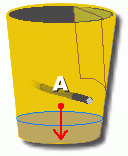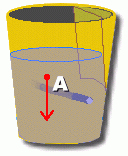|
There are no motors involved; the only things touching the bucket are the axle, and the water (from two pipes) which flows into the bucket. What makes it tip over? The principle here is the bucket's centre of mass. This mathematical concept is an imaginary point that the bucket and water would shrink to, if they were reduced to a point. It's like the average centre point of all the mass ... the mass of the bucket and water is equally centred around this point. Obviously the position of this centre of mass point will change as the bucket fills. You can find a more detailed description of centre of mass, and an explanation of why things fall over, on our 'Why Are Bowling Pins Fat At The Bottom' page. To summarize: when the centre of mass is over a point that is outside the base of the object, it will fall over. In the case of our bucket of water, the 'base' is what it rests on, the axle, which is quite narrow. The bucket should tip over pretty easily, once the water gets too high inside. But it would need some sort of nudge, since it looks like the bucket is perfectly symmetric vertically; the centre of mass should get higher and higher, but should always be directly over the axle, so the bucket won't tip unless it's given a nudge. That doesn't happen. We couldn't see inside the bucket, but here is one explanation that would cause the bucket to tip as it fills, every time. The bucket might have a partition in the upper half:
As the water level rises, the bucket is pulled more and more to the left. Eventually, when the centre of mass is far enough left to be beyond the axle, the bucket tips over. In order to make this work properly, the bottom of the bucket would probably need to be weighted, to allow the water to rise a fair distance above the axel without moving the centre of mass too fast. (If most of the mass of the bucket is in the bottom, a lot of water must be added to shift the centre of mass appreciably). |

